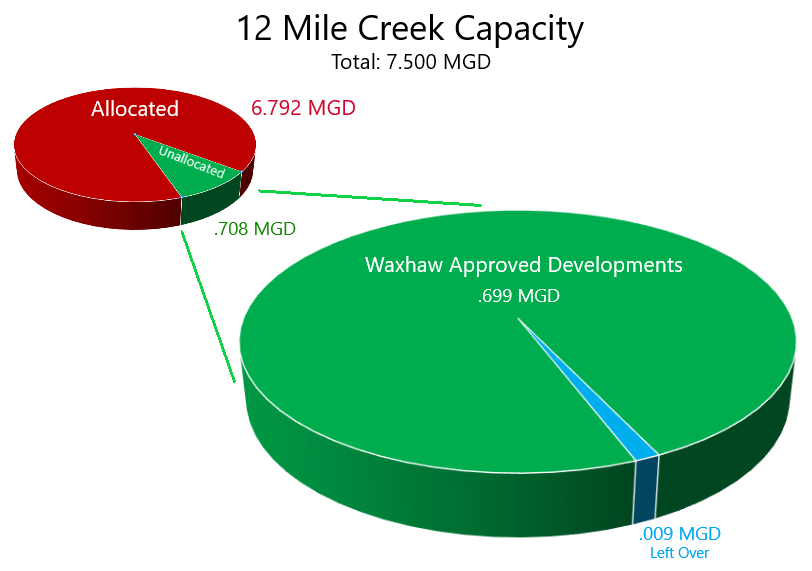
Most Waxhaw residents know about the 12 Mile Creek wastewater treatment plant on Kensington Drive. It serves Waxhaw, Weddington, Wesley Chapel, Indian Trail, Stallings, parts of Marvin, and some unincorporated areas of Union County. However, if the new residential developments approved by the Waxhaw BOC were allocated wastewater capacity tomorrow, there would be almost none of this scarce and expensive resource left for our neighboring communities.

Union County Water tracks wastewater capacity in MGD (Million Gallons a Day), and they report that the 12 Mile Creek facility has already had 90.6% of its permissible capacity allocated. The plant’s total capacity is 7.500 MGD, and 90.6% of that equals 6.792 MGD, leaving just .708 MGD available. The approved Waxhaw developments listed below would use up almost all of that remaining capacity if it were allocated to them.
Capacity is allocated through an Extension Agreement with the developer. The developer can receive the agreement as long as Union County Water have approved their sketch and full construction plans, and the developer has received all required permits from NCDEQ.
Weaponizing a Public Utility
The high percentage of allocated capacity has been portrayed as a “crisis” because it inhibits commercial growth, even though the state prohibits prioritization of commercial/industrial when allocating. In 2023, the Union County Chamber of Commerce even issued a resolution, citing the need to support new commercial and industrial development. Waxhaw, Marvin, and Weddington passed similar resolutions, and accusations flew that the Board of County Commissioners were “weaponizing a public utility” because the BOCC did not move forward with a new plant. The resolutions called on the state government to strip the county board of its power to regulate water and sewer.
It was also suggested that some of our flow could be diverted to Charlotte in order to free up capacity, but flow diversion is for convenience and emergencies to ensure safe operation, not to allow more houses to be built. It is also very expensive.
The argument that commercial and industrial development requires more wastewater capacity is disingenuous, as it ignores the capacity already allocated for residential projects. Given that residential development is the most lucrative for developers, it seems that those endorsing these resolutions are either influenced by conflicting interests or propagandized.
Expansion
An expansion is currently underway for 12 Mile Creek, which will increase its capacity from 7.5 MGD to 9 MGD (scheduled completion 2027). However, the added 1.5 MGD must be shared with our neighbors in the region. This expansion could be seen as somewhat premature, because average daily flow (actual) is currently only about 70% of the facility’s rated capacity, whereas plans for an expansion are only required if 80% is reached. Actual construction must begin by the time 90% is reached.
If all of Waxhaw’s projects were completed tomorrow, even an expanded 12 Mile would be operating at 83% allocated (7.491 is 83% of 9). Actual flow may differ. Note that 12 MGD is the actual maximum at 12 Mile, but for the sake of safe operation only 7.5 is allowed to be permitted.
In July of 2023, the Waxhaw Board of Commissioners passed a text amendment to town ordinances, allowing the use of private sewer package plants when the county is unable to provide capacity. This would allow more building to occur if the county’s capacity was already used up, but these package plants come with their own set of issues. For the amount of capacity they provide, they are very expensive, and the HOAs who usually end up responsible for them tend to do a poor job of maintenance. This can lead to improperly treated overflow.
Cost to Ratepayers

Union County Water currently permits each single family residential home at 280 GPD (Gallons Per Day), which equates to .00028 MGD per single family lot. For multifamily and townhomes they permit by the bedroom count with a minimum of 140 GPD (.00014 MGD) for 1 or 2 bedroom units and 210 GPD (.00021 MGD) for 3 bedroom units.
If we convert the .009 remainder from the above chart into single family lots, it would allow for only 32 houses to be built.
If we divide the $55 Million cost of the expansion by the MGD that each single family lot consumes, we can see that each one costs the ratepayers approximately $10,266.67. This is partially mitigated by system development fees (developers have estimated around $8k per house), but those come later while the ratepayers foot the infrastructure bill up front. It’s also worth noting that ratepayers are a subset of taxpayers, so the cost is heavier for each individual ratepayer than it would be for taxpayers as a whole.

Legal Issues Overview
General Legal Authority for Sewer System Operation and Rules
- The County has the authority, not duty, to operate a sewer utility (G.S. 153A-274 and 153A-275)
- The County has the discretion to determine the general areas for providing sewer infrastructure, with no requirement to provide service countywide to every property (G.S. 153A-283)
- The County may adopt reasonable rules to protect and regulate its sewer system (G.S. 153A-275)
Legal Constraints on Operation of County Sewer Utility (Legal Guiding Principles)
- Government utility must make decisions related to utility operations as if separate from other governmental concerns, including land use considerations (Dale v. City of Morganton, 270 N.C. 567, 573 (1967))
- Government utility may not unreasonably discriminate in the distribution of its services or establishment of rates (See Dale at 572; Fulgham v. Town of Selma, 283 N.C. 100, 105 (1953); and Wall v. City of Durham, 41 N.C.App. 649, 659 (1979))
- Utility may treat customers differently based on a utility-based rationale for which there is a substantial basis for distinction (e.g. cost/purpose/amount/character/time of service such as residential, industrial, time of day rates, bulk rates) (See Wall at 659)
- County cannot unlawfully zone municipalities through its utility by making utility decisions which do not have a utility-based rationale, but are mainly rooted in a land use rationale (See Browning-Ferris Industries of South Atlantic, Inc v. Wake County, 905 F.Supp. 312, 320 (E.D.N.C. 1995), citing Davidson County v. City of High Point, 321 N.C. 252 (1987))
- Statutory zoning powers provide for a local government’s authority to plan, restrict, and influence population and industry growth through its zoning power, not utility policy/rulemaking (See G.S. 160D-701 – 160D-702)
- Rational utilities can make decisions regarding allocation of limited resources in times of scarcity, with a plan to remedy the scarcity crisis (McCauley v. City of Jacksonville, N.C. 739 F.Supp. 278, 284 (E.D.N.C 1989), affirmed by McCauley v. City of Jacksonville, 904 F.2d 700 (table), 1990 WL 77105 (4th Cir. 1990))
Reference
For reference, these Waxhaw developments are illustrated in the chart:
- Adelina (0.143 MGD requested)
- Emerson Park (0.189 MGD requested)
- Artisan at Prescott Village (0.068 MGD requested)
- Yarbrough Farm (0.147 MGD requested)
- Amavi (0.028 MGD requested)
- Cottage Park (additional 0.043 MGD required)
- Roger’s Pond (0.035 MGD required)
- Seven Hills Subdivision (0.046 MGD requested)
Total of the above is 0.699 MGD.
